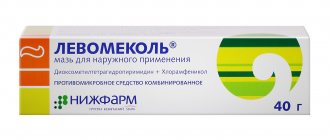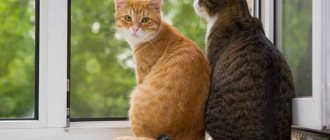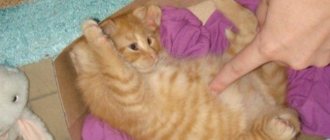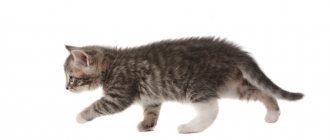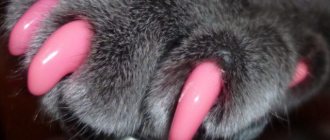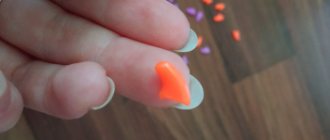Anti-scratch guards for cats are designed to protect surrounding objects and household members from the sharp claws of a pet. Popular silicone pads come in 4 sizes and can be used on kittens from 4 months of age (size XS for babies). To fix them, a special glue is used, which is included in the kit and does not cause allergies.
The service life of the covers is 1-1.5 months. It is not allowed to be worn for up to 4 months, if you are allergic to glue and for animals that walk outside, if there is a fungus or infection on the claws. On average, for a set of 40 nozzles you will have to pay up to 400 rubles.
An alternative to anti-scratch treatments can be a repeller spray (Beaphar Stop-it Cat, Biovax, Anti-scratch) and training the cat to use a scratching post.
What are anti-scratch products for cats?
Anti-scratchers for cats are silicone, rubber or plastic attachments. The useful accessory was invented as an alternative to onychectomy - a bloody operation to surgically remove a claw and part of a pet's finger. A wide selection of pet products allows you to choose anti-scratch products not only by type of material, but also by the size of your pet, and even by color.
Can it be used for kittens from 2 months of age?
Veterinary experts do not recommend using protective covers for kittens over 2 months old. Manufactured products, even of the smallest size, do not fit well on children. Curious pets can easily pick them off and swallow them. Anti-scratch products can be used starting from 4-5 months of age for a kitten. For these purposes, the smallest attachments in size XS are produced.
When you do and don't need claw protection for cats
You can use cat claw protection in the following situations:
- The animal is not accustomed to using a scratching post and damages furniture, walls, and foreign objects.
- There are small children in the house, and the pet is not always peaceful when it comes to children's games.
- Aggressive and evil character of the cat.
- Prevention of scratching when your pet is infected with fleas, develops allergies and other dermatological problems.
- The owner has health problems. Scratches from pets can cause allergies and are unsafe for bleeding disorders.
You should not use nail guards if:
- The animal has an individual intolerance to the material from which the accessory is made.
- The pet has free access to the street. A cat needs claws not only to climb trees, but also to protect itself from dogs and aggressive relatives.
- The main task of a cat is to hunt mice. The use of anti-scratches in this situation will negate all the hunting abilities of the animal.
Not a bad solution for the street
Yes, cats have been walking on their own for centuries and feel great barefoot, but not in big cities. The fact is that in many large cities, sidewalks are sprinkled with chemicals and salt to prevent slipping.
www.pinterest.com
Add to this shards of glass, all kinds of debris, asphalt hot from the sun in summer and icy winter... No, shoes are a decidedly good idea!
Features of using claw pads for cats
Claw pads for cats have the following features:
- the size of the covers should be chosen taking into account the weight of the animal;
- Anti-scratch pads should only be glued with the special glue included in the kit;
- It is not necessary to put tips on all the claws; you can “disarm” only the front paws.
Pros and cons, possible complications of declawing protection for cats
Claw protection for cats has its advantages:
- cases allow you to protect valuables from damage;
- in case of a skin disease accompanied by itching, scratching is prevented;
- facilitate bathing and other hygienic or medical procedures for an obstinate cat;
- do not harm the pet;
- the covers can be put on the claws yourself;
- are inexpensive.
Anti-scratch pads also have their disadvantages:
- independent care of hair and ears becomes impossible;
- a cat with access to the street may become a victim of aggressive relatives or dogs;
- The animal cannot cope with the task of a mouser.
Myths about nail caps
Many myths about nail caps have not been confirmed:
- Myth No. 1. The devices prevent the animal from walking. Correctly sized and applied silicone pads do not affect the pet's gait. At first, out of habit, the cat may move uncertainly, but soon its former grace returns.
- Myth No. 2 . A cat cannot retract its claws if they are covered with covers. If the instructions are followed, the soft caps cover only 2/3 of the length of the claw and do not prevent their retraction.
- Myth No. 3 . Anti-scratch products are harmful to health. Properly selected and worn covers are safe for the cat. In rare cases, the adhesive used to secure them can cause an allergic reaction.
Cat's reaction to nail covers
When using claw covers for the first time, the cat’s reaction can be very negative: some cats try to get rid of an unknown object using their teeth. However, the durable material from which the device is made protects it from furry vandals.
The cat's gait may change. As a rule, animals quickly get used to the presence of caps on their nails and after a day or two they completely forget about their existence.
In rare cases, some pets may develop an allergic reaction to the material from which the protective accessory is made.
Are anti-scratch guards harmful to cats and who should not wear them?
The opinion that anti-scratch products are harmful for cats in most cases is due to their illiterate use. Over many years of foreign practice, no cases of threat to animal health have been identified when used correctly.
You cannot put attachments on the claws of cats that have access to the street and in case of individual intolerance to the material. The minimum age for kittens to use anti-scratch products is 4 months.
Reviews from veterinarians
Reviews from veterinarians about anti-scratch products are in most cases positive. If the owner follows the instructions for their use, experts consider this invention safe for the health of the animal. Some veterinarians have expressed the opinion that false nails prevent the cat from realizing its natural instincts and make grooming more difficult.
How to choose the size of anti-scratch pads
If a person decides to get anti-scratch protection for his cat, then he needs to know how to determine the size.
Since cats are different, the size of the silicone tips is important: the same products are not suitable for the claws of a Maine Coon and a Foreign White. The age of the animal is also important.
For kittens weighing 0.5-2 kg, size S is suitable. For cats with a body weight of 2-4 kg, size M is provided. Larger cats, whose weight ranges from 4-6 kg, will fit size L.
Giants, whose breeds are included in the list of the largest cat breeds, will be in size XL.
In addition to sizes, claw covers come in different colors.
Types of nail tips
Nail tips come in different types: silicone, rubber and plastic. A variety of colors has a practical meaning - the owner can see if the cover is lost, and it is convenient to find it in the room.
Advantages of using silicone pads
Silicone pads are the most popular among owners, since the material rarely causes allergies, adheres well and does not hinder the natural movements of the animal.
How to make anti-scratch for a cat with your own hands
If desired, the owner can make anti-scratch bars for a cat on his own, using silicone and polypropylene.
How to choose the perfect “pair”
You can buy shoes for cats at most pet stores and large online supermarkets.
Choose a model to suit your taste, but pay attention to seasonality and waterproofness, as well as natural and hypoallergenic materials.
www.pinterest.com
Pay attention to the presence of a protector on the sole - it prevents slipping and prevents the paws from moving apart. The boots are secured with Velcro or lacing. It should be strong enough, but not squeeze the foot.
How to put on your cat's nails
You should put false nails on your cat after the claws have been trimmed. If separation of the stratum corneum is observed, then it is necessary to trim the surface with a file.
How to properly glue a cat's nails
The following instructions will help you glue your cat’s nails correctly:
- prepare 5 silicone caps from the package;
- apply a small amount of glue into the cavity of the nozzle (no more than 1/3 of the volume);
- disinfect the claws on the cat’s paw with an antiseptic;
- Having pressed on the crumb, extend the claw and place the cap on it, gently pressing it on all sides;
- similarly glue attachments to all the pet’s claws;
- when the anti-scratch for the cat is glued, the animal should be held so that the glue sets, and after 10-15 minutes the cat with false nails can be released;
- Glue from the owner's fingers can be removed with nail polish remover.
If the pet is mischievous and breaks out, then you can attract an assistant and wrap the cat in a blanket for the procedure.
Anti-scratch for cats: instructions on how to use
There are no special instructions for using anti-scratch pads for cats; the animal simply wears them until they either rip them off or they fall off along with the renewal of the nail. If your pet chews and eats the cover, it’s okay. It will come out naturally without damaging the walls of the stomach and intestines.
Anti-scratch glue
Glue is included with the cases. A non-toxic product is used to attach silicone tips. In rare cases, the glue used to attach false nails can cause an allergy in your cat.
How to remove anti-scratch pads from a cat's claws
You can remove scratch guards from your cat’s claws when the stratum corneum of the claw grows back. In this case, the nozzle disappears on its own. This happens after about 1-2 months, depending on the intensity of the natural processes of claw regrowth in the cat.
If you need to remove them a little earlier, then you need to carefully trim the tip of the cover and pull it off.
Disadvantages of shoes for cats
Unfortunately, not all cats are calm about innovations. Some are horrified by the very idea of interfering in their precious life and refuse to wear not only shoes, but also a collar, a warm sweater or a New Year's hat for a photo shoot.
www.aliexpress.com
You need to gradually accustom your pet to boots, first wearing them only at home for a short period of time and carefully monitoring the reaction. If the cat is categorically stubborn, looks unhappy and constantly tries to rip the new clothes off his paws - what can you do?
This cat seems to have completely forgotten how to walk:
Anti-scratch alternative
An alternative to anti-scratching can be a cat repellent spray, training the animal to use a scratching post, or special socks.
Anti-scratch spray
Anti-scratch sprays contain repellent substances, such as essential oils, which furry creatures do not like. The most popular repeller sprays among owners are Beaphar Stop-it Cat, Biovax, Antiscratch (True Friend) and Antiscratch pheromones for cats.
Scratchy
A scratching post or scratching post is a device for grinding down claws in apartment living conditions. You can purchase a horizontal or vertical modification at a pet store. Most often, jute rope, sisal, and corrugated cardboard are used for its production. Some pets will like a wooden scratching post.
Getting used to using the device will not be difficult if you buy a finished product specially impregnated with aromatic agents.
Table: pros and cons of anti-scratch products
| Pros of anti-scratch | Cons of anti-scratch pads |
| Reliably protects owners' personal property from scratches | The cat cannot hunt and defend itself from territorial rivals |
| Protect owners and other pets from cat aggression | An animal can fall from a height because there is nothing to cling to |
| Replaces declawing surgery | An incorrectly fixed cap can cause inflammation |
| Easy to put on and take off | Possible psychological discomfort |
| Have a wide range of sizes | Individual intolerance |
| Suitable for animals of all ages | Frequent change of caps |
| Retains the ability to retract claws | With constant use, your pet's claws deteriorate. |
| Does not cause discomfort to the pet | Hygiene procedures are difficult |
| Does not interfere with natural nail growth | They make a peculiar knocking sound when the cat moves |
| Anti-scratch material is safe for cats | |
| Does not interfere with the active life of the animal | |
| If it enters the stomach, it is easily eliminated naturally | |
| They make the cat irresistible and give it individuality |
Despite many controversial issues, anti-scratch products still have more advantages than disadvantages. Before you decide to put protective caps on your cat, you should read on the forums not only reviews from veterinarians, but also the opinions of animal owners who have tested the accessory.
Basic questions when purchasing
When faced with the choice of whether to buy such devices for your pets or get by with the classic “sharpening” of claws/surgery, a number of related questions arise. For example:
- What happens if an animal swallows the bait? Nothing bad will happen. The caps are made of non-toxic material, have a smooth surface and, when ingested, can easily pass through the entire gastrointestinal tract and exit naturally.
- How quickly will the cat get used to the new condition? Everything is individual. Usually the adaptation process lasts 2-5 days, during which she may get nervous and try to chew or remove the interfering accessory, but then she gets used to it and resigns herself.
- Will the habit of sharpening your claws go away? No, the instinct remains, the animal will still release its claws, but it simply will not be able to harm furniture, walls, wallpaper or a person.
- Which manufacturer is better? The best brands that have proven themselves in this area are: Soft Paws Nail Caps For Cats (USA), Cliny, Crazy Liberty (Russia), Barbos (Russia).
When overlays are needed
Anti-scratch caps (second name) are oblong caps made of soft plastic or silicone. They follow the shape of the claw and are “settled” on top using special medical glue. It is hypoallergenic and suitable for most cats without causing any discomfort.
Although not all owners and veterinarians support the idea of wearing such attachments, there are several reasons when it is still worth purchasing them and teaching your pet to walk in them.
- Small children.
Kids love to play with cats, cuddle, pull by the tail, pinch and show love in other “non-standard” ways. Not all animals are able to tolerate bullying and react calmly to it. Some may use their claws as a defense and inadvertently injure the child's skin. In such cases, anti-scratches will be one hundred percent justified. - Protection of household items.
Not only sofa upholstery, wallpaper and door frames, but also curtains, carpets, children's toys, and clothes often suffer from tenacious cat claws. To protect interior and wardrobe items from damage (often irreversible), you will have to use overlays.
- Character traits.
It happens that cats cannot be re-educated or show aggression towards their owners, guests, children, etc. They can rush at imaginary offenders, scratch themselves, break free from their hands - behave nervously and inappropriately. Or hurt other domestic animals present on their territory. The use of caps will reduce the risk of injury and slightly pacify the cat's temper. - Household safety.
Here we are talking about possible harm to health. The claws contain microbes, and if there are deep scratches, they can enter the wound, causing inflammation. In the worst case, blood poisoning. People who have weak immunity, poor blood clotting, or a predisposition to various allergic reactions should beware of damage.
How to glue overlays: instructions
The procedure involves not only mechanical actions, but also a corresponding psychological component. Do not forget that for an animal any manifestation of violence against its freedom is a great stress.
- Sit the cat on your lap, stroke it, talk in a calm voice, affectionately, without pressure.
- Take one paw and press on the pad until the nail appears. Try on the cap to see if it fits properly. If necessary, cut to the required length on the side of the hole through which it is inserted.
- Treat the inside of the lining with the glue from the kit. The silicone surface should be covered no more than 1/3.
- Put on the nozzle using a sliding motion, press on both sides for about 3-5 seconds until the glue sets.
- After 10 minutes, check how well the anti-scratches are fixed and, if necessary, make corrections.
- Praise the cat for its patience and treat it with a tasty treat.
Price
Anti-scratch kits for cats are sold as a set of caps of the selected size and glue, as well as instructions. The cost of one set is in the range of 250-350 rubles (for 20 pieces in a set).
A greatly reduced price may be a reason to doubt the integrity of the seller. Usually, cheapness is achieved by selling low-quality glue , which can cause an allergic reaction or even poisoning if swallowed.



